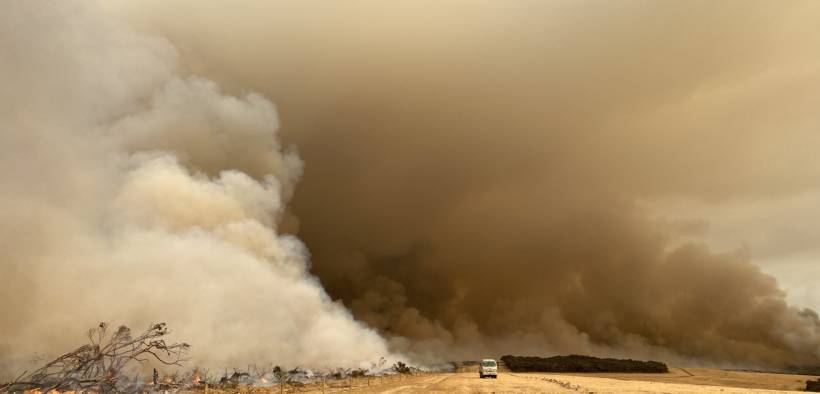Over 1 Billion Animals Believed Dead in Australia Wildfires

The already devastating Australian wildfires are on pace to be the worst environmental disaster of the last century.
Updated figures from the University of Sydney’s Faculty of Science have now doubled the impact of Australia’s wildfires on wildlife with the fires now killing an estimated one billion animals or more across the country.
Just weeks ago, the loss of animal life was estimated at 500 million but the fires, which first started in September, have continued to burn on and have expanded their range. Estimates of the size of Australia’s wildfires vary, anywhere from 15 million acres to 25 million, for perspective the state of Louisiana is 25 million acres.
Most recently, the Sydney Morning Herald reported on Friday that a new 1.5 million acre “megafire” had formed in southeastern Australia in the Snowy Mountains which sits along the border between Australia’s most populous states New South Wales and Victoria.
Professor Chris Dickman of the University of Sydney gave the revised estimate of the loss of animal life in an interview with NPR in the U.S.
“The 480 million estimate was made a couple of weeks ago, and the fires have now burnt over a large area of the further country. That means over 800 million mammals, birds and reptiles have been affected by the fires. Australia-wide, it’s probably over a billion,” Dickman said. “I think there’s nothing quite to compare with the devastation that’s going on over such a large area so quickly. It’s a monstrous event in terms of geography and the number of individual animals affected.”
Dickman’s figures are based on a 2007 report for the World Wildlife Fund (WWF) on the impact of land clearing in Australia. That report amassed estimates of mammalian, bird and reptile population density in New South Wales. However, the University of Sydney reported those estimates were highly conservative and didn’t include figures for frogs, insects or other invertebrates.
Australia is noted both for its rich biodiversity – including over 300 native mammalian species – and for having the highest extinction rate of mammals. At least 34 species and subspecies of native mammals have become extinct in Australia over the last 200 years.

Fire Captain Dave Soldavini, holds a baby kangaroo, known as a “Joey,” that was rescued from the devastating 2019-20 wildfires in Australia, January 2020. (Photo: Australian Forest Service)
“What we’re seeing are the effects of climate change. Sometimes, it’s said that Australia is the canary in the coal mine with the effects of climate change being seen here most severely and earliest… We’re probably looking at what climate change may look like for other parts of the world in the first stages in Australia at the moment,” Professor Dickman told NPR.
“I think there is a feeling among environmental scientists and ecologists in Australia that we’ve been frozen out of the debate, certainly out of policymaking. I think it’s now time to bring the scientists back into the tent to look at what is likely to be happening over the next few decades and to think about how we can maintain both the human community in good health and as much biodiversity as can be retained under this evolving situation.”
WWF-Australia issued a statement backing Dickman’s figures and warned, “some species may have tipped over the brink of extinction.”
“WWF-Australia is appalled at the scale of destruction, but we are not surprised as the science has been warning us for a decade that this was coming.
“Australia is a land of bushfires, but this season’s unprecedented mega fires are not normal. Climate change does not cause bushfires, but it does make them much worse,” added WWF-Australia.
Scenes of the devastation of Australia’s fires have been shared widely across Twitter:
A shocking video of dead animals strewn across a roadside in New South Wales killed in the #AustralianBushfire .
At least 480 million mammals, birds and reptiles are likely to have died in the state alone since September. Devastating.
Credit: The ‘new’ Batlow Hotel pic.twitter.com/BaGFsMvfm6
— Patrick Greenfield (@pgreenfielduk) January 5, 2020
As Peter Castagno previously reported for Citizen Truth critics have blasted the Australian government for its ties to the coal industry and for failing to heed the warnings that climate change would cause increasingly devastating wildfires. As far back as 2007, a report from the Intergovernmental Panel on Climate Change warned that climate change was “virtually certain” to exacerbate heatwaves in Australia in both intensity and frequency.
“The first obligation of government is to protect citizens,” tweeted Greenpeace Australia Pacific CEO David Ritter. “Since 2013, there have been at least 18 expert warnings of climate change bringing catastrophic fires. Not only is there no effective plan to cut emissions, but Morrison and co knew this was coming and did not prepare.”
Additionally, as Castagno wrote, a joint investigation between Australian investigative journalist Michael West and Greenpeace Australia uncovered the vast control international coal and gas interests hold over the Australian government, with at least 36 top politicians having ties to the fossil fuel and resource extraction industries.
“One link isn’t significant, a number of links aren’t that significant,” said investigative journalist Michael West about his investigation into shadowy coal lobbying groups and the government. “But when you identify – as this investigation has done – a raft of links, and you look at the individuals, people going from the coal lobby to politics back to the coal lobby you can see that this network must have a powerful influence over government and the policies of government in this country.”















